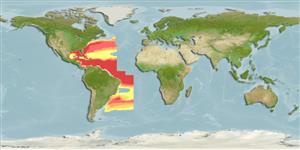Common names from other countries
>
Argentiniformes (Marine smelts) >
Argentinidae (Argentines or herring smelts)
Etymology: Glossanodon: Greek, glossa = tongue + Greek, anodos = without teeth (Ref. 45335).
More on author: Cohen.
Issue
Needs a taxonomic reference.
Environment: milieu / climate zone / depth range / distribution range
Ecologia
marinhas batipelágico; intervalo de profundidade 92 - 458 m (Ref. 37473), usually 183 - 366 m (Ref. 37473). Deep-water
Western Atlantic: South Carolina to southern Florida, in the northern Gulf of Mexico, and off Cuba, Nicaragua, Venezuela, and northern Brazil.
Tamanho / Peso / Idade
Maturity: Lm ? range ? - ? cm
Max length : 11.3 cm SL macho/indeterminado; (Ref. 37473)
Raios dorsais (total) : 10 - 12; Raios anais : 11 - 13. Slender body. Swim bladder lacking silvery pigment. Light tan ground color in alcohol (Ref. 37473).
Inhabits muddy, sand and gravel bottom (Ref. 37473). Sexual maturity reached around 8 cm SL, with female of 7.72 cm SL with ripe eggs and male of 8.66 cm SL with well-developed testes (Ref. 84005).
Ciclo de vida ou comportamento de acasalamento
Maturities | Reprodução | Spawnings | Egg(s) | Fecundities | Larvas
Robins, C.R., R.M. Bailey, C.E. Bond, J.R. Brooker, E.A. Lachner, R.N. Lea and W.B. Scott, 1991. Common and scientific names of fishes from the United States and Canada. Am. Fish. Soc. Spec. Publ. (20):183 p. (Ref. 3814)
Status na Lista Vermelha da UICN (Ref. 130435)
CITES (Ref. 128078)
Not Evaluated
Ameaça para os humanos
Harmless
Uso pelos humanos
Ferramentas
Relatórios especiais
Baixar XML
Fontes da internet
Estimates based on models
Preferred temperature (Ref.
115969): 10.4 - 20.8, mean 14.9 (based on 111 cells).
Índice de diversidade filogenética (Ref.
82804): PD
50 = 0.5001 [Uniqueness, from 0.5 = low to 2.0 = high].
Bayesian length-weight: a=0.00363 (0.00163 - 0.00807), b=3.17 (2.98 - 3.36), in cm Total Length, based on LWR estimates for this (Sub)family-body shape (Ref.
93245).
Nível Trófico (Ref.
69278): 3.0 ±0.00 se; based on food items.
Resiliência (Ref.
120179): Elevada, tempo mínimo de duplicação da população menor que 15 meses (Preliminary K or Fecundity.).
Fishing Vulnerability (Ref.
59153): Low vulnerability (10 of 100).
